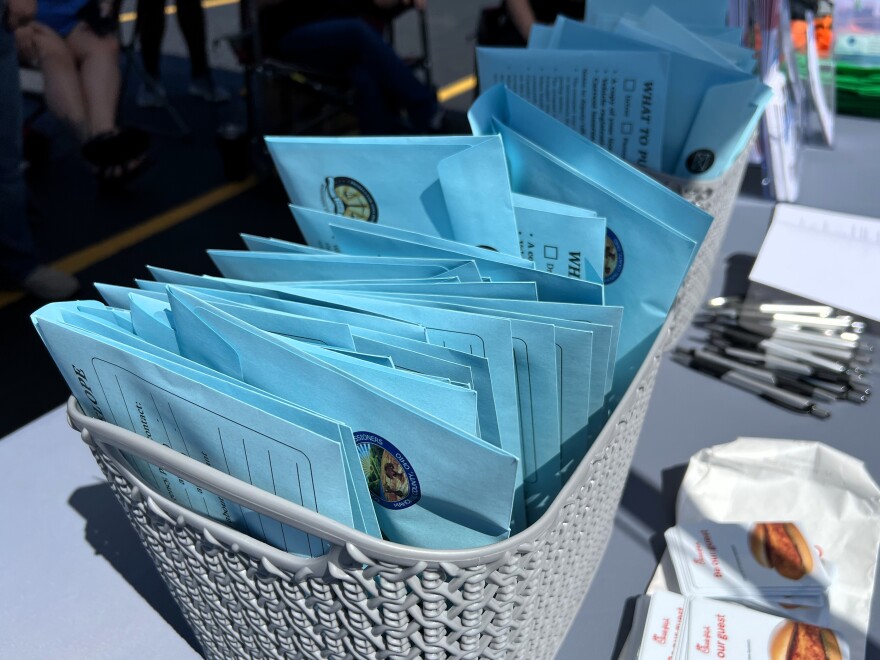This article was originally published on July 29, 2024.
Russ Maddick likes to drive. In his free time, he goes shopping at Goodwill and drives to restaurants like Arby’s and Domino’s.
“Every Saturday, I go with my coworkers for eggs and coffee,” he said.
Maddick has an intellectual disability, so sometimes it can be tricky for him to communicate with people outside of his normal circle, like the police.
That’s why he’s in a parking lot in the Youngstown suburb of Austintown pulled over in front of a cop car.
“I pulled you over today. Is something going on?” said a deputy approaching his vehicle.
Maddick wasn’t stopped for speeding, or failing to signal or any other traffic infraction. Instead, he’s practicing this interaction as part of a new program meant to help people like him and law enforcement.
The Blue Envelope Program
The Blue Envelope program’s name is literal, said Mahoning County Prosecutor Gina DeGenova.
“The program is actually a blue envelope. What happens is when somebody is pulled over for a traffic stop, they have this about a five by seven [inch] blue envelope.”

After learning about the program, which has already been adopted by police departments in states like Connecticut and California, DeGenova introduced it to her corner of northeast Ohio. As far as she knows, it’s the first of its kind in the state.
It’s intended for people with conditions or disabilities like anxiety, autism and dementia, and their loved ones. Anyone who’s interested fills out the front of a blue envelope with information for police.
“Sometimes what we have found with individuals with special needs, they have sensitivity to lights and sirens,” DeGenova said. “They may exhibit signs of impairment based upon their condition.”
Drivers can write down their medical conditions, or accommodations like the need for additional time to answer questions or clear, simple language. On the inside of the envelope, they can put insurance information and their car registration.
“What this is designed to do is de-escalate the situation,” DeGenova said, “provide information to the police officer who’s stopping the car and to say, ‘Hey, listen, here's what's going on here.’”
How can this program help?
There’s a number of examples in recent years of people with disabilities experiencing violence — or even dying — at the hands of police.
Robert Ethan Saylor, a 26-year-old with Down syndrome went to see a movie in 2013. After he returned for a second showing without paying, witnesses say police couldn’t get him to leave, so they held him down and handcuffed him. The medical examiner ruled his death a homicide by asphyxiation.
In 2016, police shot and killed Keith Lamont Scott, a Black man with a brain injury, who they say was holding a gun. His family claimed he was holding a book at the time. Police released photos of a gun and holster at the scene, and after an investigation, the district attorney decided not to charge the officer involved.
More recently, in March, a sheriff’s deputy in California shot and killed Ryan Gainer, a 15-year-old with autism who was holding a gardening tool.
According to Disability Rights Ohio, people with disabilities are more likely than the general population to experience physical force and brutality at the hands of police. The organization says about 20% of Americans are disabled, but people with disabilities make up 30 to 50% of those that experience police use of force.
"Anything that we can do to help law enforcement assess a situation, and provide them with information that would help them to do so, is a win in our book."Gina DeGenova, Mahoning County Prosecutor
DeGenova recognizes law enforcement has a responsibility to take care of everyone, regardless of ability.
“It is easy to expect a lot from our law enforcement. And we should because they're here to serve and protect,” she said. “But they're not magicians. They're not mind readers. And I think it is very important, especially for me as a prosecutor who represents law enforcement, who wants to try to reduce crime in our community, to provide all of the information that we can to help our law enforcement succeed.”
Local police officers like Giana Musolino believe the program can make a difference.
“It definitely changes the tone of the traffic stop,” she said.
Her cousin has autism, and she knows he struggles if his routine is disrupted — which would happen if he’s pulled over.
“And then this would actually help us de-escalate and everything,” she said.
As Musolino and another officer walked Russ Maddick through his practice traffic stop, Maddick seemed pretty relaxed.
“I’ve been happy,” he told the officers.
If he’s ever pulled over for real though, emotions might run higher. But Maddick will be better prepared with a blue envelope, and law enforcement will be too.
“Because then they know what’s going on,” Maddick said.


